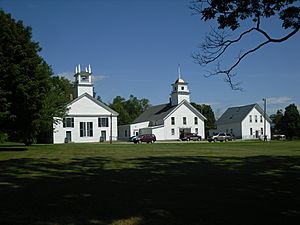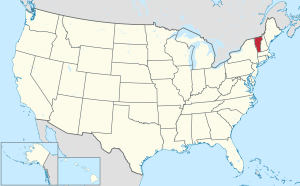Essex County, Vermont facts for kids
Quick facts for kids
Essex County
|
|
|---|---|

Essex County Courthouse in Guildhall
|
|

Location within the U.S. state of Vermont
|
|
 Vermont's location within the U.S. |
|
| Country | |
| State | |
| Founded | 1800 |
| Named for | Essex |
| Shire Town | Guildhall |
| Largest town | Lunenburg |
| Area | |
| • Total | 675 sq mi (1,750 km2) |
| • Land | 664 sq mi (1,720 km2) |
| • Water | 12 sq mi (30 km2) 1.7%% |
| Population
(2020)
|
|
| • Total | 5,920 |
| • Density | 8.770/sq mi (3.386/km2) |
| Time zone | UTC−5 (Eastern) |
| • Summer (DST) | UTC−4 (EDT) |
| Congressional district | At-large |
Essex County is a county located in the northeastern part of the U.S. state of Vermont. As of the 2020 census, the population was 5,920, making it the least-populous county in both Vermont and New England. Its shire town (county seat) is the municipality of Guildhall. The county was created in 1792 and organized in 1800. Bordered by the Connecticut River next to New Hampshire, Essex County is south of the Canadian province of Quebec. It is the county with the lowest household-income in Vermont.
Contents
History
Prior to the arrival of colonists of European descent, the local Abenakis had subsisted largely on moose.
Vermont was divided into two counties in March, 1778. In 1781 the legislature divided the northernmost county, Cumberland, into three counties: Windham and Windsor, in approximately the modern location for those counties. The northern remainder was called Orange County. This latter tract nearly corresponded with the old New York county of Gloucester, organized by that province March 16, 1770, with Newbury as the shire town.
On September 3, 1783, as a result of the signing of the Treaty of Paris, the Revolutionary War ended with Great Britain recognizing the independence of the United States. Vermont's border with Quebec was established at 45 degrees north latitude.
On November 5, 1792, the legislature divided Chittenden and Orange counties into six separate counties, as follows: Chittenden, Orange, Franklin, Caledonia, Essex, and Orleans. No reason is given for the county being named after the county of Essex in England.
In 1999, a group of investors bought 86,212 acres (34,889 ha) from Champion International Paper for $7.5 million, covering parts of fourteen towns in the county. The state of Vermont and the Freeman Foundation purchased easements for $8.5 million to guarantee traditional uses of the land for logging and recreation. In 2008, Plum Creek Timber company announced plans to purchase this property.
Demographics
| Historical population | |||
|---|---|---|---|
| Census | Pop. | %± | |
| 1800 | 1,479 | — | |
| 1810 | 3,087 | 108.7% | |
| 1820 | 3,284 | 6.4% | |
| 1830 | 3,981 | 21.2% | |
| 1840 | 4,226 | 6.2% | |
| 1850 | 4,650 | 10.0% | |
| 1860 | 5,786 | 24.4% | |
| 1870 | 6,811 | 17.7% | |
| 1880 | 7,931 | 16.4% | |
| 1890 | 9,511 | 19.9% | |
| 1900 | 8,056 | −15.3% | |
| 1910 | 7,384 | −8.3% | |
| 1920 | 7,364 | −0.3% | |
| 1930 | 7,067 | −4.0% | |
| 1940 | 6,490 | −8.2% | |
| 1950 | 6,257 | −3.6% | |
| 1960 | 6,083 | −2.8% | |
| 1970 | 5,416 | −11.0% | |
| 1980 | 6,313 | 16.6% | |
| 1990 | 6,405 | 1.5% | |
| 2000 | 6,459 | 0.8% | |
| 2010 | 6,306 | −2.4% | |
| 2020 | 5,920 | −6.1% | |
| U.S. Decennial Census 1790–1960 1900–1990 1990–2000 2010–2020 |
|||
2010 census
As of the 2010 United States Census, there were 6,306 people, 2,818 households, and 1,814 families residing in the county. The population density was 9.5 inhabitants per square mile (3.7/km2). There were 5,019 housing units at an average density of 7.6 per square mile (2.9/km2).
Of the 2,818 households, 24.2% had children under the age of 18 living with them, 51.0% were married couples living together, 8.7% had a female householder with no husband present, 35.6% were non-families, and 29.3% of all households were made up of individuals. The average household size was 2.23 and the average family size was 2.70. The median age was 47.4 years.
The median income for a household in the county was $37,734 and the median income for a family was $46,263. Males had a median income of $37,021 versus $28,710 for females. The per capita income for the county was $20,040. About 13.0% of families and 16.9% of the population were below the poverty line, including 25.8% of those under age 18 and 10.3% of those age 65 or over.
Geography
According to the U.S. Census Bureau, the county has a total area of 675 square miles (1,750 km2), of which 664 square miles (1,720 km2) is land and 12 square miles (31 km2) (1.7%) is water.
Adjacent counties
- Coos County, New Hampshire – east
- Grafton County, New Hampshire – south
- Caledonia County – southwest
- Orleans County – west
- Coaticook Regional County Municipality, Quebec – north
Major Routes
Vermont Route 102
Vermont Route 105
Vermont Route 114
Fauna
In 2011, there were about 1,000 moose in the county. State officials estimated that this was about the "correct number" for a sustainable herd, with the moose not showing signs of starvation, nor the feeding grounds showing signs of overgrazing.
National protected area
Economy
Personal income
The median income for a household in the county was $30,490, and the median income for a family was $34,984. Males had a median income of $27,929 versus $20,583 for females. The per capita income for the county was $14,388. About 9.90% of families and 13.70% of the population were below the poverty line, including 17.30% of those under age 18 and 12.90% of those age 65 or over.
The median wage is the lowest in the state, and that status is expected to continue through 2010.
Housing
In 2007, Essex was the only county in the state to have a positive Housing Affordability Index on housing; i.e. the average household can afford to buy the average house. Both figures are the lowest in the state.
Media
WVTI 106.9 broadcasts from Island Pond, Vermont.
Communities
Towns
Census-designated places
Unincorporated communities
In Vermont, gores and grants are unincorporated portions of a county which are not part on any town and have limited self-government (if any, as many are uninhabited).
See also
 In Spanish: Condado de Essex (Vermont) para niños
In Spanish: Condado de Essex (Vermont) para niños

